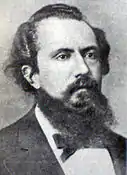1874 Argentine presidential election
The Argentine presidential election of 1874 was held on 12 April to choose the president of Argentina. Nicolás Avellaneda was elected president.
| ||||||||||||||||||||||||||
228 members of the Electoral College 115 votes needed to win | ||||||||||||||||||||||||||
|---|---|---|---|---|---|---|---|---|---|---|---|---|---|---|---|---|---|---|---|---|---|---|---|---|---|---|
| ||||||||||||||||||||||||||
 Most voted party by province. | ||||||||||||||||||||||||||
| ||||||||||||||||||||||||||
Background
President Sarmiento's pragmatic approach to Buenos Aires demands and his successful control of separatist revolts in the north paved the way to high office for his vice president, Autonomist Party leader Adolfo Alsina. Alsina gained the support of a sizable facion of Mitre's Nationalist Party, resulting in the formation of the paramount political group in Argentina for the next 42 years: The National Autonomist Party (PAN). Mitre himself did not support Alsina, however, whom he viewed as a veiled Buenos Aires separatist. The elder statesman ran for the presidency again, though the seasoned Alsina outmaneuvered him by fielding Nicolás Avellaneda, a moderate lawyer from remote Tucumán Province. The electoral college met on 12 April 1874, and awarded Mitre only three provinces, including Buenos Aires.
As he had repeatedly up to 1861, Mitre took up arms again. Hoping to prevent Avellaneda's 12 October inaugural, he mutineered a gunboat; he was defeated, however, and only President Avellaneda's commutation spared his life.[1]
Results
| Argentine Republic | |
|---|---|
| Population | 2,154,000 |
| Voters | 25,800 |
| Turnout | 1.2% |
| Presidential Candidates | Party | Electoral Votes |
|---|---|---|
| Nicolás Avellaneda | National | 145[lower-alpha 1] |
| Bartolomé Mitre | Nacionalist | 79 |
| Total voters | 224 | |
| Did not vote | 4 | |
| Total | 228 | |
| Vice Presidential Candidates | Party | Electoral Votes |
|---|---|---|
| Mariano Acosta | National | 145[lower-alpha 1] |
| Juan Eusebio Torrent | Nacionalist | 79 |
| Total voters | 224 | |
| Did not vote | 4 | |
| Total | 228 | |
Results by Province
| Province | President | Vice President | |||
|---|---|---|---|---|---|
| Avellaneda | Mitre | Acosta | Torrent | ||
| Buenos Aires | 53 | 53 | |||
| Catamarca | 12 | 12 | |||
| Córdoba | 25 | 25 | |||
| Corrientes | 16 | 16 | |||
| Entre Ríos | 17 | 17 | |||
| Jujuy | 8 | 8 | |||
| La Rioja | 8 | 8 | |||
| Mendoza | 10 | 10 | |||
| Salta | 12 | 12 | |||
| San Juan | 10 | 10 | |||
| San Luis | 10 | 10 | |||
| Santa Fe | 12 | 12 | |||
| Santiago del Estero | 1 | 16 | 1 | 16 | |
| Tucumán | 14 | 14 | |||
| Total | 145[lower-alpha 1] | 79 | 145[lower-alpha 1] | 79 | |
Notes
- Todo Argentina: 1874 Archived 2017-11-05 at the Wayback Machine (in Spanish)
- Although only 145 electors voted for Avellaneda and Acosta, in the final count they appear with 146 votes.
References
- Diario de Sesiones de la Cámara de Senadores del Año 1874. Buenos Aires: Compañía Sud-Americana de Billetes de Banco. 1896. pp. 289–292.
- Duhalde, Eduardo Luis (2007). Acción Parlamentaria de John William Cooke. Buenos Aires: Colihue. p. 232. ISBN 978-950-563-460-6.
- Lorenzo, Celso Ramón (1999). Manual de Historia Constitucional Argentina, Volumen 3. Rosario: Editorial Juris. p. 8. ISBN 950-817-111-1.
- "Historia Electoral Argentina (1912-2007), p. 58" (PDF). www.mininterior.gov.ar. Ministry of the Interior. December 2008. Retrieved 13 June 2017.

